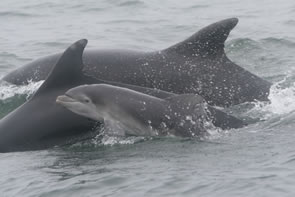

Lingering over Luing
Hilda Bransby, Education Officer
It was a memorable day from the start, and not because it was the thirteenth of the month. While waiting for the Luing ferry we watched a group of bottlenose dolphins in Cuan sound. They chased us across on the ferry, which provided some excellent educational material for the day's school visit.
We were welcomed on arrival at Luing Primary school by smiley faces leaning over the wall and offers of help to carry our equipment. What a great start to the day! We worked with the students in two groups (split by age) for half a day each. This is fairly typical when we visit small primary schools.
We began with introductions and a name game when Jade becomes a jellyfish and Hilda a hermit crab. During the introductory presentation we discussed questions such as what does HWDT do? What whales, dolphins and porpoises are found here? How can they be identified? How do they communicate and find food? Who is Duncan the dolphin? How and why do we use photo-ID? What threats are there to cetaceans?
The older students worked in groups experiencing some photo-ID using cards with unidentified dorsal fin shots and a 'board' showing identified animals. The students matched the photos successfully and gained some basic understanding of cetacean research.
Jade challenged the students to guess what marine animals they were, after we had put animal stickers on their backs. Students, of course, hadn't read their own ones. All students enjoyed asking questions to deduce their animal. What is long, silvery, small, swims in shoals and is the favourite food of puffins? What is pyramid shaped, has a hard shell and eats algae?
Animal passports revealed facts to students about their animal, to develop knowledge, in preparation for the next activity. Some did not know that an octopus has three hearts and is about as intelligent as a dog or that an anemone can slide very slowly. In the next activity students completed a task to 'find someone who...' has three hearts, for example. Or who's favourite food is mussels, or who swims in shoals?
Another activity involved building an interactive basking shark using all students to become parts of the animal. Most popular was perhaps being the tail, holding arms up, swinging from side to side. Not only were there actions but also phrases to remember to explain the sharks adaptations. For example, the gills said 'breathe and filter'.
The final activity was a review using, for example, a 'magic' pebble which stored special memories of the day. We had completed our visit, although we did linger to look for more dolphins.
